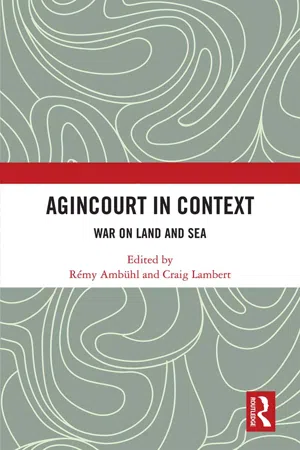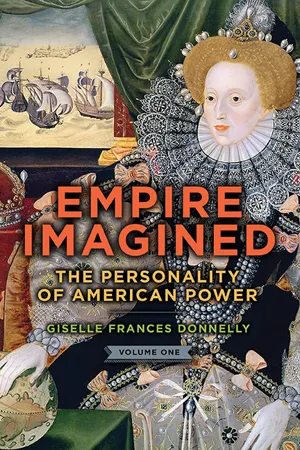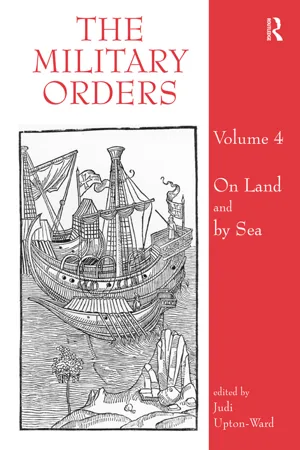History
The Portuguese Armada
The Portuguese Armada, also known as the Invincible Armada, was a fleet of ships sent by King Philip II of Spain to support Portugal in its struggle for independence from Spain. The armada was defeated by the English navy in 1588, marking a significant turning point in naval warfare and European history.
Written by Perlego with AI-assistance
Related key terms
4 Key excerpts on "The Portuguese Armada"
- eBook - ePub
Agincourt in Context
War on Land and Sea
- Rémy Ambühl, Craig Lambert(Authors)
- 2018(Publication Date)
- Routledge(Publisher)
1 This article charts these martial developments and re-examines Anglo-Portuguese relations during this phase of the Hundred Years War.England and international affairs in 1415 from a Portuguese perspective
In a royal chronicle of the conquest of the Mahgrebi enclave of Ceuta, which provides some information about the soldiers from countries other than Portugal involved in the campaign, one captain in particular is singled out: ‘a wealthy citizen of England, known as Momdo , coming into the service of the king with four or five ships with many archers and other people’.2 In April 1415 an Aragonese spy in Lisbon, Ruy Díaz de Vega, confirmed that a certain Mundy de Arcamua was expected to put ashore from London with four merchant ships. He further reported that 10 English ships totalling 850 tons were docked in the Tagus ready to join the expedition, each with 20 men.3 Such evidence has been taken as proof not only of the commitment of the English crown to supporting the Portuguese military enterprise, but also as a manifestation of the continuing vitality of the Anglo-Portuguese alliance established earlier.4The notion of a solid Anglo-Portuguese union is long-standing, yet requires reassessment. On the brink of a major campaign himself in 1415, Henry V could hardly have contemplated lending serious military assistance to his Portuguese uncle. In September 1414 and January 1415 he had provided two Portuguese emissaries, João and Álvaro Vaz de Almada, with licences to ship weapons and armour out of England duty free.5 But that was the limit of his assistance. The English captain ‘Momdo’, identified as Edmund Arnald, a Gascon entrepreneur based in Dartmouth, was acting on his own volition.6 The treaty of Windsor (1386) had been the last in a series of Anglo-Portuguese agreements aimed at reinforcing the position of both kingdoms in the Iberian theatre of the Hundred Years War.7 - eBook - ePub
Empire Imagined
The Personality of American Power, Volume One
- Giselle Frances Donnelly(Author)
- 2022(Publication Date)
- SUNY Press(Publisher)
Gran Armada has been often and, occasionally, well told. The sailing and sighting of the “Invincible Armada,” the initial skirmishes, the employment of “fireships” and the battle off Gravelines in Flanders, the fortuitous blowing of the “Protestant wind” that scattered the Duke of Medina Sidonia’s disorganized fleet, and its later wrecks off the coasts of Ireland are all central components in the making of Elizabethan myth. Less well remembered is the effectiveness of the Dutch in bottling up Parma’s army and its barges. But perhaps the most strategically revealing moments of the encounter came in the aftermath, in the Portugal expedition that followed.Figure 4.1. Theater of Maritime Operations, 1588–1589.THE ENGLISH ARMADA
On August 9, 1588, the day after the clash off Gravelines, Lord Burghley had written to Walsingham that he was “not of the opinion that the Spanish fleet will suddenly return from the north or the east, being weakened as they are, and knowing that our navy is returned to our coast where they may repair their lacks and be strong as before.”14 It took an additional two weeks to confirm that the Spanish fleet had sailed northwards past the Orkneys and thus past the point of no return where they must loop entirely around Scotland and Ireland to sail for home. With the immediate danger of invasion also past, at the end of August 1588 Elizabeth summoned her closest councilors to ponder her next move. For all the rejoicing over the defeat of the Spanish, no one expected that it was a decisive moment; Philip would come again. Now was the time to mount a counteroffensive to exploit what surely would be a fleeting moment of Spanish weakness. The first impulse was to try to intercept the American treasure fleet, but the English fleet was in no condition for that, according to the reports of Charles Howard, the Earl of Nottingham and lord admiral, and Francis Drake. Nonetheless, some countering blow had to be readied, the initiative seized, and the naval victory exploited. Sir John Norris was also brought in to consult on land-force matters.What would become the Portugal expedition of 1589—“the English Armada” to Spanish historians15 —is, like the Northern Rebellion two decades previously, a little-studied but greatly revealing story of British strategy-making. It was also a textbook example of the ineradicable “maritime” or “blue-water” element that emphasized naval power and colonial commerce and sought to avoid entanglement in continental European affairs in British strategic culture and the improvised, “public-private” method of generating military forces that betrayed the weakness of the Elizabethan state. By mid-September 1588, it was agreed that the survivors of the wreck of the Gran Armada were likely to return to Spain and Portugal for refitting and that a raid of the sort that Drake specialized in would forestall the building of a new Spanish fleet. Burghley made note of a September 20 meeting to decide objectives: “(1) to attempt to burn the ships in Lisbon and Seville; (2) to take Lisbon; (3) to take [the Azores, the way station for the treasure fleet].”16 - eBook - ePub
The Military Orders Volume IV
On Land and By Sea
- Judi Upton-Ward, Judi Upton-Ward(Authors)
- 2016(Publication Date)
- Routledge(Publisher)
What lesson can be drawn from the comparison between these two pictures? In both cases, the Orders of Christ and Santiago were present in the command of the fleets (38.5% on the voyage of 1500–1501; 57.1% on the voyage of 1502–3). There are clear differences between the two voyages, however. On the latter voyage, there was clearly much greater control by the military orders: not only were more than half of the captains connected to them (as has already been noted), but the command of each fleet was, without exception, entrusted to knights of these two orders; and these were, at the same time, close relatives of the commander-in-chief Vasco da Gama (Vicente Sodré was his uncle and Estêvão da Gama was his cousin). Furthermore, Lopo Mendes de Vasconcelos was Vasco da Gama’s brother-in-law and Brás Sodré was another of his uncles; Dom Luis Coutinho and Pedro Afonso de Aguiar were close relatives. It is therefore possible to detect a dual ‘network’ (connections within the orders themselves and, simultaneously, family links), thus emphasizing an overlapping logic that has been insufficiently studied, but which deserves much more careful research.In any case, there was clearly an increased ‘militarization’ of the armada of 1502–3, through the greater presence of knights of the orders. This fact can be easily explained if we take into account the particularly delicate set of circumstances represented by the Portuguese presence in the East in its initial phase. Indeed, when I referred earlier to the novelty brought by the arrival of the Portuguese in India in 1498, I drew attention to something that did in fact grow to be more important: the intensification of the debate upon the option to be pursued by the Portuguese monarchy, a debate that took place precisely in the short period between the arrival in Portugal of Pedro Álvares Cabral (summer of 1501) and the departure of Vasco da Gama (March 1502).The terms of this debate are well known. As can be read in the chronicles of João de Barros,… in these first voyages, trade was not so visible either in itself or with their arrival, since their information was very confused in comparison with what was to be known, in the following armadas, about the grandeur of that conquest. However, with the things that Pedro Álvares [Cabral] traded alone, they made this difference, saying that it was one thing to deal with the question of whether it would be good to discover unknown land, seemingly inhabited by such peaceful and obedient people as were those of Guinea and the whole of Ethiopia, with whom we had communication, that without arms or any other sign of war, through the exchange of things of little value we would have a great deal of gold, spices and other things fetching a high price; and another thing was to consider whether it would be convenient and advantageous to this kingdom, for reasons of trade of the things from India, to venture to want them through force of arms.18 - eBook - ePub
The First World Empire
Portugal, War and Military Revolution
- Hélder Carvalhal, André Murteira, Roger Lee de Jesus, Hélder Carvalhal, André Murteira, Roger Lee de Jesus(Authors)
- 2021(Publication Date)
- Routledge(Publisher)
Estado from the 1520s onwards.However, this does not invalidate that there was, though only occasionally, a certain degree of technical or tactical superiority. For instance, the case of the defence of Goa in 1512 was carried out by using an ordinance system inspired by European tactical advances. These cases, however, did not constitute the majority of Portuguese military operations in Asia and cannot be deduced as examples of their military presence in the continent. As Jeremy Black stated, warfare was waged by European countries across the world “quite effectively and decisively without reference to Western methods, technology and politics.”59In this sense, the idea of a military revolution, as seen by Geoffrey Parker, poorly applies to the Portuguese case. Although the development of artillery and shipbuilding enabled the Portuguese Kingdom to have unprecedented firepower on board, the other arguments contained in this concept have no full applicability either in the kingdom or in the construction and consolidation of the Estado da Índia. On an architectural note, Portuguese forts in Asia gradually integrated the innovations developed in Europe: not until 1546–7 was the first bastion front (in Diu) built, followed by the bastion layout of the fortress of São Sebastião of Mozambique. The number of Portuguese soldiers also grew slightly over the course of the sixteenth century, though the size and capacity of recruitment did not increase during this period. The development of a bureaucratic apparatus was therefore unconnected to the expansion of military needs, and the Crown could not effectively control its subjects, given that part of them took on an informal presence in Asia outside the royal domain, in what is known as the Shadow/Informal Empire.60
Index pages curate the most relevant extracts from our library of academic textbooks. They’ve been created using an in-house natural language model (NLM), each adding context and meaning to key research topics.



